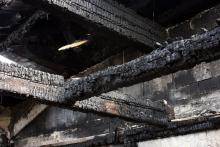
May 19 2020

The ‘Code of Practice for Investigators of Fire and Explosions for the Criminal Justice System in the UK’ (https://www.ife.org.uk/write/MediaUploads/Documents/Fire_Investigation_Code_of_Practice.pdf)has been in operation since April 2017, yet KBC experts continue to encounter fire investigation cases that fall well short of what is now expected.
In a recent case we were asked to review a large fire scene as a paper exercise, relying on the report, notes and photographs of the prosecution expert. The report was extensive, but the notes and images underpinning it were sadly lacking in key detail. Indeed the only images made available to us in the case had been downloaded by the prosecution investigator from ‘social media (source unknown)’. They had not taken any of their own scene photographs to support their opinions and conclusions regarding the origin and cause of the fire.
Appropriate documentation of a fire scene is essential both as an aide memoire for the original investigator, and to enable a future review of the original scene by experts who are instructed after the scene is reinstated. Without sufficient documentation it may not be possible for an expert to fully support their opinions or exclude alternative reasons for the fire. We produced a report highlighting a number of issues. The Crown discontinued the case.
Analysis and preservation of physical items can also be an issue. A fire in a bedroom was documented with scene photographs that showed fire damage was confined almost entirely to the bed. The defendant stated that, on the morning of the fire, she used a heated belt on the bed to relieve pain; she had then left the house. The prosecution fire investigator found what he described as a mobile phone type charger plugged into an electrical socket in the bedroom, but he found no trace of electrical wiring for a heated belt on the bed. His investigation concluded the fire was started deliberately. KBC was instructed to review the evidence from the papers and photographs. Our report noted that the heated belt was battery-powered and had a mobile-phone type charger, which was consistent with the physical evidence but that evidence had not been properly examined or retained to check further. Given the presence of the unidentified charger in the room and the potential for battery-powered products to cause fires, the heated belt was considered a credible alternative fire cause to that offered by the Crown. After submitting our report, the Crown offered no evidence.
The lack of scene preservation and insufficient documentation/ information can lead to improperly-considered conclusions that are not scientifically sustainable. The fire service was alerted to a fire in a wooden building located close to a large bonfire. The first crew found the building well alight. The initial fire incident report gave the cause of the fire as ‘accidental’. Two prosecution fire investigators subsequently accessed the scene six and ten days after the fire. In the intervening period, the scene had not been preserved, had been substantially disturbed and partially cleared. The building in question was constructed of readily-combustible materials, there was evidence of additional combustible fuels being stored within, and the fire occurred during a warm, dry summer. Dried vegetation was in the immediate vicinity.
Fire tests by one of the prosecution investigators demonstrated this vegetation burned fiercely once lit and in a manner that could have ignited the building. At odds with the initial fire incident report and without apparent consideration of the ignition tests, both prosecution investigators concluded the most likely cause of the fire was deliberate ignition with a naked flame, and that there was no likelihood that a flying brand from the bonfire caused the fire. KBC’s investigation found that, due to the lack of scene preservation, the precise status of the scene pre- and post-fire was not known and could not be established. The available evidence and the results of the ignition tests demonstrated that the fire could have been started deliberately with a naked flame or via a flying brand from the bonfire; it was not possible to eliminate either of these as a potential cause. At trial half time the judge halted the case due to the reasonable possibility it was an accidental fire.
The Government requires all fires in the UK to be ‘investigated’ by the fire service and a most likely cause ascertained for data collection and statistical analysis purposes. There is no requirement that suspected arson fires be investigated thoroughly and this responsibility lies with the Police. On occasion and through no fault of their own, some fire officers with little training and experience of fire investigation find themselves nominated the prosecution expert in cases involving charges as serious as arson with intent to endanger life. Their report may be written following no more than a cursory visual ‘examination’ of the scene.
In cases like these, it can be hard to determine from the initial papers that the ‘evidence’ is more of a data collection exercise for statistical reporting and not a properly detailed examination and recording of the scene by an expert for criminal prosecution purposes. Our experts at KBC are well accustomed to reviewing others’ work and can quickly identify the strengths and limitations of the Prosecution’s evidence once we begin our own, more-detailed investigations.
Fire investigation is a very complex area of forensic science and there are many steps needed in properly considering ALL of the relevant evidence in each case. If you have a case where the outcome of a fire investigation is an issue, or you simply want an initial chat about a fire case, then please contact us for help and advice. We have seen a number of fire cases where the disclosed report is outwardly convincing but, on more detailed inspection of the supporting materials by our experts, critical deficiencies have been identified in scene examination procedure and/or interpretation of the evidence.
Our fire investigation experts, Jennefer Gray, Alan Henderson and Dr David Schudel can be contacted at the Durham office on 0191 332 4999.